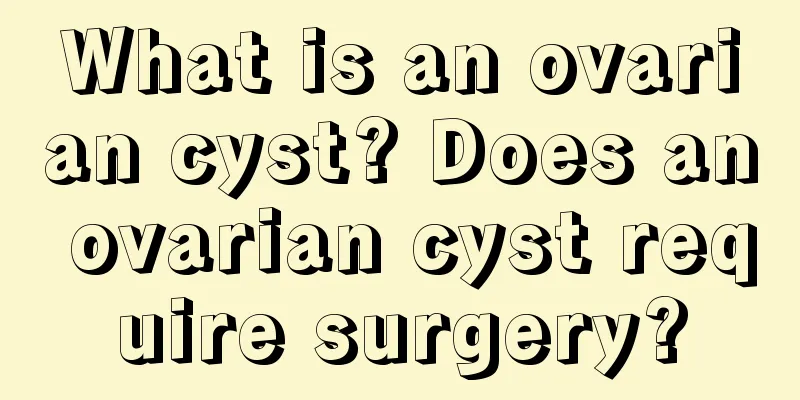What is an ovarian cyst? Does an ovarian cyst require surgery?

|
I believe many women have had this experience: just because they went to the obstetrics and gynecology department for a smear test, or to check their vaginal discharge, or to feel discomfort in the lower abdomen, or to have irregular menstruation, the doctor told them that they had an ovarian cyst, and they were inevitably nervous. So what is an ovarian cyst? Does an ovarian cyst require surgery? What is ovarian cystHygroma is actually a common term, medically known as cyst. Generally speaking, although there are several types of cysts, when a doctor tells you that it is a hygroma, it generally means that the contents are all light liquid. As for endometriosis commonly known as menstrual tumors or chocolate cysts, fallopian tube and ovarian abscesses caused by inflammation, and tumors with solid parts inside, they are usually not called hygroma. Most cysts are benign, especially those that are small. Not only are they benign, but you don't have to worry about them getting worse. So for those with a diameter of less than five or six centimeters, most people don't recommend surgery. But you have to make sure that the cyst is full of liquid and has no solid parts before you can rest assured. But if the cyst occurs more than two years after menopause, you need to consider it differently, because after menopause, you no longer ovulate, so theoretically, functional cysts will no longer appear. The cause of cysts depends on their type. Functional cysts, such as follicular cysts and corpus luteum cysts, are related to hormone secretion. Follicles will appear in the ovaries near the ovulation day during the normal menstrual cycle. They usually grow to more than two centimeters before ovulation. Occasionally, they grow to three centimeters in size and look like a cyst. Even after ovulation, a corpus luteum will form, which can still grow to three or four centimeters, or even more than five centimeters. These follicles or so-called functional cysts, i.e. follicular tumors or corpus luteum tumors, are not only benign, but also disappear after the next menstrual period. Therefore, if an ultrasound scan is taken again, there may be no cysts. In addition, some true ovarian neoplasms, such as cystic adenomas and simple cysts that grow from ovarian epithelial cells, are similar to malignant tumors, and the true cause of their formation is unknown. Does ovarian tumor require surgery?In fact, most ovarian tumors are benign, including follicular cysts formed by larger follicles, corpus luteum cysts formed by larger corpus luteum, mucinous or serous cystic adenomas, chocolate cysts, and fallopian tube ovarian abscesses caused by inflammation. Even in the samples taken by surgery, only 10 to 15 percent of ovarian tumors are malignant. Generally speaking, cysts without a solid part are mostly benign. Therefore, if the diameter is less than 5 cm, there is no need to worry. If the diameter is 5 to 10 cm, careful follow-up examination is required. If it does not shrink or disappear within two months, laparoscopic surgery can be considered for removal. If it appears after menopause, surgery is recommended. If it is more than 10 cm, surgery should be performed as soon as possible, because the chance of malignancy is higher and it usually does not disappear. If the tumor has a solid part, a thick septum, tumors on both sides, irregular protrusions on the surface of the tumor, or water accumulation in the abdominal cavity, then the probability of malignancy is high and surgery should be performed as soon as possible. Therefore, if ultrasound scans reveal an ovarian tumor that is not a simple cyst, it is advisable to seek medical treatment as soon as possible. For small cysts, if you are very concerned about it not going away, there is currently a non-surgical method, which is ultrasound-guided puncture. It can save 70% to 80% of the time, but there is a 20% to 30% recurrence rate, so some doctors do not recommend it. Laparoscopic surgery can also be used to remove the tumor completely without laparotomy. However, if the cyst has a solid part or a septum, it is best to open the abdomen for exploration because there is a higher chance of ovarian cancer. What is a teratomaThere is a type of ovarian tumor that is not a simple cyst. Sometimes the contents are still mostly liquid, but because it contains some special components, it can usually be diagnosed by ultrasound before surgery. That is a teratoma. Even before medical ultrasound, teratomas can be detected by X-ray because this tumor contains teeth, cartilage, sebaceous glands, hair, etc. Teratomas are formed when some germ cells get lost during the embryonic period. Teratomas in women are mostly found in the ovaries, but occasionally in the uterus or fallopian tubes. Teratomas in men are usually found in the testicles or vas deferens. Most teratomas are benign, and only a few are malignant. The former are mostly cyst-like, also known as dermoid cysts, because they mainly contain skin and related tissues; the latter are mostly solid, that is, solid. Very few benign teratomas can turn into malignant ones, so surgical removal is still the best option. This strange ovarian tumor accounts for about 15% of ovarian tumors and is also the most common ovarian tumor in girls under 20 years old. It can be as small as a few millimeters and will not be discovered unless it is X-rayed or ultrasounded. It can be as large as 30 or 40 centimeters, causing abdominal distension. Because most of them are benign, some tumors that are less than 4 or 5 centimeters may not be discovered until old age, but in fact they have coexisted peacefully for decades. Clinically, like other ovarian tumors, teratomas are mostly asymptomatic. When they grow to a certain size, symptoms such as abdominal distension, lower abdominal pain, frequent urination, constipation, and incomplete defecation will occur. However, if torsion or rupture occurs, there will be acute lower abdominal pain and emergency surgery is required. Thanks to the advancement of ultrasound technology, most ovarian tumors with special components can be easily diagnosed. Color Doppler ultrasound can determine whether a solid teratoma is malignant. Even if it is malignant, as long as it is not ruptured, the effect of surgery is quite good, and chemotherapy can be added if necessary. Indications for ovarian tumor surgery1. The ovarian cyst is larger than 5 cm and has not shrunk or disappeared after 6 to 8 weeks of observation. 2. Ovarian tumor with solid part. 3. There are papillary growths on the wall of the ovarian cyst. 4. Any ovarian mass larger than 10 cm. 5. There is ascites. 6. Ovarian tumors that occur before menstruation or after menopause. 7. Suspected ovarian tumor torsion or rupture (usually causing severe pain). |
<<: What should I do if my baby has a stuffy nose? What should I do if my baby spits up?
Recommend
What are the symptoms of early pregnancy? Is bleeding in early pregnancy normal?
Usually most girls will be very careful when they...
How old is the baby able to speak? How to train the baby to speak?
Babies will start babbling when they are 4 months...
Is water birth painful? Conditions and requirements for water birth
Water birth is different from other birthing meth...
How to treat children's adenoids hypertrophy? Dietary taboos for children's adenoids hypertrophy
Adenoid hypertrophy is a common disease in childr...
Can the navel of a newborn baby be disinfected with iodine? It is best to dilute it
The navel of a newborn baby needs careful care. S...
How to treat endometritis during pregnancy preparation
Women who have endometritis during pregnancy shou...
What does it mean when a pregnant woman dreams of a dog? Will the baby be a boy or a girl if a pregnant woman dreams of a dog?
Many pregnant women will have fetal dreams during...
Will pregnancy spots disappear after giving birth? What are pregnancy spots?
Many pregnant women will develop pregnancy spots ...
What are the common symptoms of baby strabismus and how to correct it
Does your child tilt his head or squint when look...
Will my mother's myopia be passed on to her children? Will my mother's myopia be passed on to her children?
Will myopia be inherited by the mother? Today, I ...
How to improve education for children who are too introverted
Sometimes children are too shy and introverted. T...
How to wean your baby? Five things to note when weaning your baby
When the baby grows to a certain stage, it is nec...
Can I wear makeup during pregnancy? Can I use skin care products during pregnancy?
It is the nature of every girl to love beauty, bu...
How to judge whether your child is active or hyperactive
Children are undoubtedly the center of our family...
What is the purpose of the confinement cap to protect? Can the confinement cap be replaced by an ordinary hat?
Postpartum caps are a product that many mothers a...









